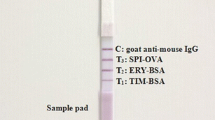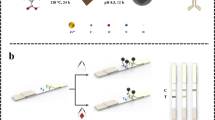Abstract
The neomycin residues in milk could pose potential hazard for human health, and now, immunoassays are widely used for on-site screening of neomycin and other food contaminate residues. In this paper, the neomycin B was conjugated with carrier protein as immunogens, and a highly specific antibody was produced. Based on the produced antibody, an enzyme-linked immunosorbent assay (ELISA) and a new flow-through immunoaffinity chromatography test (FTIACT) were developed for rapid analysis of neomycin B residues in milk. The developed ELISA has a detection limit of 162.5 pg/mL in milk, which is suitable for detecting neomycin B residues at picogram levels, while the optimized FTIACT exhibited satisfactory compatibility with the ELISA, with limits of detection of 326.8 fg/mL in milk, which is more suitable for on-site detecting neomycin B residues at femtogram levels. For the quantitative FTIACT, the recoveries from spiked milk ranged from 69 to 131%, with a relative standard deviation of less than 15%. Compared to traditional ELISA formats, the developed FTIACT provided lower detection limits for neomycin B residue analysis.






Similar content being viewed by others
References
Arsand JB, Jank L, Martins MT, Hoff RB, Barreto F, Pizzolato TM, Sirtori C (2016) Determination of aminoglycoside residues in milk and muscle based on a simple and fast extraction procedure followed by liquid chromatography coupled to tandem mass spectrometry and time of flight mass spectrometry. Talanta 154:38–45. https://doi.org/10.1016/j.talanta.2016.03.045
Asakawa D, Uemura M, Sakiyama T, Yamano T (2018) Sensitivity enhancement of aminoglycosides in hydrophilic interaction liquid chromatography with tandem mass spectrometry by post-column addition of trace sodium acetate in methanol. Food Addit Contam A 35:1116–1126. https://doi.org/10.1080/19440049.2017.1388543
Barreto F, Jank L, Castilhos T, Rau RB, Tomaszewski CA, Ribeiro C, Hillesheim DR (2019) Chemical residues and mycotoxins in raw milk. Raw Milk. Elsevier, Amsterdam, pp 273–293
Beloglazova NV, Goryacheva IY, Rusanova TY, Yurasov NA, Galve R, Marco MP, De Saeger S (2010) Gel-based immunotest for simultaneous detection of 2,4,6-trichlorophenol and ochratoxin A in red wine. Anal Chim Acta 672:3–8. https://doi.org/10.1016/j.aca.2010.05.024
Burkin M, Galvidis I (2011) Development and application of indirect competitive enzyme immunoassay for detection of neomycin in milk. Appl Biochem Micro. 47:321–326. https://doi.org/10.1134/S0003683811030045
Chen Y-Q, Shang Y-H, Wu X-P, Qi Y-T, Xiao X-L (2007) Enzyme-linked immunosorbent assay for the detection of neomycin in milk: effect of hapten heterology on assay sensitivity. Food Agr Immunol 18:117–128. https://doi.org/10.1080/09540100701579829
Chen Y, Shang Y, Li X, Wu X, Xiao X (2008) Development of an enzyme-linked immunoassay for the detection of gentamicin in swine tissues. Food Chem 108:304–309. https://doi.org/10.1016/j.foodchem.2007.10.022
Community Reference Laboratories Residues (2010) Guidelines for the validation of screening methods for residues of veterinary medicines (Initial validation and transfer). http://ec.europa.eu/food/food/chemicalsafety/residues/Guideline_Validation_Screening_en.pdf. Accessed 1 May 2021
Delatour T, Racault L, Bessaire T, Desmarchelier A (2018) Screening of veterinary drug residues in food by LC-MS/MS. Background and challenges. Food Addit Contam A 35:633–646. https://doi.org/10.1080/19440049.2018.1426890
EU Pharmacopia (2005) Fifth Edition, Neomycin Sulphate. Section 0197. The Council of Europe; Strasbourg, France, 2005; www.pheur.org
Gaudin V, Rault A, Hedou C, Soumet C, Verdon E (2017) Strategies for the screening of antibiotic residues in eggs: comparison of the validation of the classical microbiological method with an immunobiosensor method. Food Addit Contam A 34:1510–1527. https://doi.org/10.1080/19440049.2017.1339331
Han R-W, Yu Z-N, Zhen T-Y, Wang J (2017) Survey of veterinary drug residues in raw milk in Hebei Province, China. J Food Protect 80:1890–1896. https://doi.org/10.4315/0362-028X.JFP-17-105
He J, Wang Y, Zhang X (2016) Preparation of artificial antigen and development of IgY-based indirect competitive ELISA for the detection of kanamycin residues. Food Anal Method 9:744–751. https://doi.org/10.1007/s12161-015-0248-x
Jiang W, Beloglazova NV, Wang Z, Jiang H, Wen K, de Saeger S, Luo P, Wu Y, Shen J (2015) Development of a multiplex flow-through immunoaffinity chromatography test for the on-site screening of 14 sulfonamide and 13 quinolone residues in milk. Biosens Bioelectron 66:124–128. https://doi.org/10.1016/j.bios.2014.11.004
Jiang W, Beier RC, Luo P, Zhai P, Wu N, Lin G, Wang X, Xu G (2016) Analysis of pirlimycin residues in beef muscle, milk, and honey by a biotin–streptavidin-amplified enzyme-linked immunosorbent assay. J Agr Food Chem 64:364–370. https://doi.org/10.1021/acs.jafc.5b05711
Jiang W, Beloglazova NV, Luo P, Guo P, Lin G, Wang X (2017) A dual-color quantum dots encoded frit-based immunoassay for visual detection of aflatoxin M1 and pirlimycin residues in milk. J Agr Food Chem 65:1822–1828. https://doi.org/10.1021/acs.jafc.6b05337
Jin Y, Jang J-W, Lee M-H, Han C-H (2006) Development of ELISA and immunochromatographic assay for the detection of neomycin. Clin Chim Acta 364:260–266. https://doi.org/10.1016/j.cca.2005.07.024
Li G, Liu C, Zhang X, Luo P, Lin G, Jiang W (2021) Highly photoluminescent carbon dots-based immunosensors for ultrasensitive detection of aflatoxin M1 residues in milk. Food Chem 355:129443. https://doi.org/10.1016/j.foodchem.2021.129443
Loomans EEMG, Van Wiltenburg J, Koets M, Van Amerongen A (2003) Neamin as an immunogen for the development of a generic ELISA detecting gentamicin, kanamycin, and neomycin in milk. J Agr Food Chem 51:587–593. https://doi.org/10.1021/jf020829s
Luo PJ, Zhang JB, Wang HL, Chen X, Wu N, Zhao YF, Wang XM, Zhang H, Zhang JY, Zhu L, Jiang WX (2016) Rapid and sensitive chemiluminescent enzyme immunoassay for the determination of neomycin residues in milk. Biomed Environ Sci 29:374–378. https://doi.org/10.3967/bes2016.048
Shi Q, Huang J, Sun Y, Deng R, Teng M, Li Q, Yang Y, Hu X, Zhang Z, Zhang G (2018) A SERS-based multiple immuno-nanoprobe for ultrasensitive detection of neomycin and quinolone antibiotics via a lateral flow assay. Microchim Acta 185:84. https://doi.org/10.1007/s00604-017-2556-x
Siljanoski A, Ciglarič R, Pezdir T, Lainšček PR, Dolenc J, Starič J, Šinigoj-Gačnik K (2018) Detection of tetracycline and other antimicrobial residues in milk from cows with clinical mastitis treated by combination therapy. J Dairy Res 85:321–326. https://doi.org/10.1017/S0022029918000389
Tian Y-F, Chen G-H, Guo L-H, Guo X, Mei X-Y (2015) Methodology studies on detection of aminoglycoside residues. Food Anal Method 8:1842–1857. https://doi.org/10.1007/s12161-014-0067-5
Tölgyesi Á, Barta E, Sohn M, Sharma VK (2018) Determination of antimicrobial residues in honey by liquid chromatography tandem mass spectrometry. Food Anal Method 11:2043–2055. https://doi.org/10.1007/s12161-018-1166-5
Trullols E, Ruisánchez I, Rius FX (2004) Validation of qualitative analytical methods. TrAC Trends Anal Chem 23:137–145. https://doi.org/10.1016/S0165-9936(04)00201-8
US Pharmacopeia (2006) The National Formulary. Neomycin Sulfate. USP 29, NF 24, 2006, p. 1491
Wan Y-C, Liu Y-J, Liu C, Ma H-T, Yu H-F, Kang J-W, Gao C-L, Wu Z-Q, Zheng D, Lu B (2018) Rapid determination of neomycin in biological samples using fluorescent sensor based on quantum dots with doubly selective binding sites. J Pharmaceut Biomed 154:75–84. https://doi.org/10.1016/j.jpba.2018.02.028
Wang S, Xu B, Zhang Y, He J (2009) Development of enzyme-linked immunosorbent assay (ELISA) for the detection of neomycin residues in pig muscle, chicken muscle, egg, fish, milk and kidney. Meat Sci 82:53–58. https://doi.org/10.1016/j.meatsci.2008.12.003
Wang X, Luo P, Chen J, Huang Y, Jiang W (2016a) Development of a quantitative immuno-affinity test column assay for on-site screening of clindamycin residues in milk. Int Dairy J 55:59–63. https://doi.org/10.1016/j.idairyj.2015.12.002
Wang Y, Li S, Zhang F, Lu Y, Yang B, Zhang F, Liang X (2016b) Study of matrix effects for liquid chromatography–electrospray ionization tandem mass spectrometric analysis of 4 aminoglycosides residues in milk. J Chromatogr A 1437:8–14. https://doi.org/10.1016/j.chroma.2016.02.003
Wang X, Yang S, Li Y, Zhang J, Jin Y, Zhao W, Zhang Y, Huang J, Wang P, Wu C, Zhou J (2018) Optimization and application of parallel solid-phase extraction coupled with ultra-high performance liquid chromatography–tandem mass spectrometry for the determination of 11 aminoglycoside residues in honey and royal jelly. J Chromatogr A 1542:28–36. https://doi.org/10.1016/j.chroma.2018.02.029
Wu Q, Peng D, Liu Q, Shabbir MAB, Sajid A, Liu Z, Wang Y, Yuan Z (2019) A novel microbiological method in microtiter plates for screening seven kinds of widely used antibiotics residues in milk, chicken egg and honey. Front Microbiol 10:436. https://doi.org/10.3389/fmicb.2019.00436
Xu N, Qu C, Ma W, Xu L, Xu L, Liu L, Kuang H, Xu C (2011) Development and application of one-step ELISA for the detection of neomycin in milk. Food Agr Immunol 22:259–269. https://doi.org/10.1080/09540105.2011.569882
Zhu Y, Son JI, Shim Y-B (2010) Amplification strategy based on gold nanoparticle-decorated carbon nanotubes for neomycin immunosensors. Biosens Bioelectron 26:1002–1008. https://doi.org/10.1016/j.bios.2010.08.023
Zhu Z, Liu G, Wang F, Sasanya JJ, Cannavan A (2016) Development of a liquid chromatography tandem mass spectrometric method for simultaneous determination of 15 aminoglycoside residues in porcine tissues. Food Anal Method 9:2587–2599. https://doi.org/10.1007/s12161-016-0446-1
Funding
This work was financially supported by the National Natural Science Foundation of China (No. 31972763 and No. 31602103), the Natural Science Foundation of Guangdong Province, China (No. 2019A1515011834), the Science and Technology Planning Project of Guangdong Province, China (No. 2017B020207009), the Shenzhen Basic Research Projects (No. JCYJ20190808160003705), the Sanming Project of Medicine in Shenzhen (No. SZSM201611068), and the medical young scientists program in Shenzhen University.
Author information
Authors and Affiliations
Contributions
Chen Liu: project administration and formal analysis; Yanliang Jiang: project administration and writing—original draft; Linyun Xiu: project administration; Ruijun Qian: formal analysis; Mengxi Zhao: project administration; Pengjie Luo: validation; Yuebin Ke: methodology; Guangming Li: conceptualization; Wenxiao Jiang: funding acquisition, supervision, and writing—review and editing.
Corresponding author
Ethics declarations
Ethics Approval
All applicable international, national, and/or institutional guidelines for the care and use of animals were followed. This article does not contain any studies with human participants performed by any of the authors.
Informed Consent
Not applicable.
Conflict of Interest
Chen Liu declares that she has no conflict of interest. Yanliang Jiang declares that he has no conflict of interest. Linyun Xiu declares that she has no conflict of interest. Ruijun Qian declares that she has no conflict of interest. Mengxi Zhao declares that she has no conflict of interest. Pengjie Luo declares that he has no conflict of interest. Yuebin Ke declares that he has no conflict of interest. Guangming Li declares that he has no conflict of interest. Wenxiao Jiang declares that he has no conflict of interest.
Additional information
Publisher’s Note
Springer Nature remains neutral with regard to jurisdictional claims in published maps and institutional affiliations.
Supplementary information
ESM 1
(DOCX 320 kb)
Rights and permissions
About this article
Cite this article
Liu, C., Jiang, Y., Xiu, L. et al. Ultratrace Analysis of Neomycin Residues in Milk at Femtogram Levels by Flow-Through Immunoaffinity Chromatography Test. Food Anal. Methods 14, 2298–2307 (2021). https://doi.org/10.1007/s12161-021-02058-5
Received:
Accepted:
Published:
Issue Date:
DOI: https://doi.org/10.1007/s12161-021-02058-5




